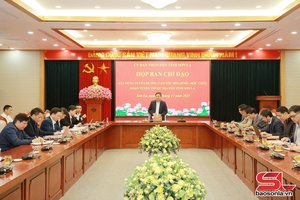

The Dao ethnic group in Vietnam is divided into many branches that share the same language but show basic differences in clothing. Dao Tien is the only group wearing skirts, with indigo being the main colour. In Son La, the Dao Tien ethnic group accounts for about 1.7% of the province's population, living mainly in some hamlets of Moc Chau, Van Ho and Phu Yen districts. Although Dao Tien people’s costumes are not as colourful as those of the Red Dao, they have impressive highlights with elaborate pattern-making techniques, containing many meanings about the ethnic group’s traditional concepts and beliefs.
According to the Dao people, costumes must be dyed with natural indigo and be recognised when performing ethnic religious rituals. Indigo is used as the main colour to embroider and draw traditional patterns on both skirt and shirt. Pattern on the skirt must follow the samples. As for scarves and shirts, in addition to sample patterns, each person can have their own ideas, as long as they maintain traditional beauty. Only women who are skillful, diligent, and meticulous can make costumes with beautiful patterns and beautiful colours.

A complete men's outfit includes a shirt, a headband and pants, with indigo as the main colour and some patterns on the shirt embroidered with white thread. The women's costume is always more elaborate with a shirt, a skirt, a head scarf, leggings, a belt and some silver jewelry. Each part of the costume must go through elaborate and time-consuming manufacturing steps. The scarf and shirt are made from raw white fabric that is dyed with indigo, then patterns are embroidered on the front side of the fabric. The fabric is cut to make the scarf, which is attached with beads and tassels by red or pink thread. Particularly, the shirt is embroidered with cascading patterns with coloured threads on its hem and back. The highlight is the stylised square pattern symbolising the sun embroidered on the back of the shirt with the red, yellow, white, and blue on the elegant black indigo background.
Particularly, Dao women's skirt is made most meticulously with many stages cutting fabric, drawing patterns with beeswax, dyeing with indigo, arranging fabric pieces and sewing to create the perfect shape of the dress. The patterns on the skirt follow the six samples: coins, horizontal stripes, stacked rectangles, rectangles with lines inside, white waves, and indigo waves. These patterns are all drawn with beeswax on a white fabric background, then dyed with indigo many times, dried, and melted with beeswax so that the parts painted with beeswax retain their original white colour with beautifully drawn patterns standing out on the indigo background. The patterns on the skirt all express the concept of life in the beliefs of the Dao people, depicting the daily life, mountains, rivers and the desire for a prosperous and good life through the meaning of the rows of coin patterns along the dress.
A highlight of the Dao Tien ethnic people’s costume is the silver coins attached to the back of the shirt, on the scarf and on the skirt, combined with silver jewelry such as earrings, necklaces and bracelets. In the beliefs of the Dao Tien, white silver represents wealth, prosperity, and wealth. Silver coins are associated with the belief of worshipping. They are wedding gifts and also objects that keep the soul of the dead.

Nowadays, people do not need to grow cotton or weave fabric but can choose ready-made white coarse fabrics. Only the waist belt is hand-woven with threads, used for both men and women on appropriate occasions.
From ancient times, the Dao people still believe that embroidery and making costumes represent a woman's talent, virtue, ingenuity, diligence, and hard work. In order to remember the pattern sets, grasp the technique of indigo dyeing and know how to mix thread colours, girls must learn from a young age. They must practice over many years to perfect their skills and be really patient and meticulous to make the complete outfits.

Women play a key role in creating costumes and preserving the nation's traditions. They are also responsible for passing on the art of creating patterns to the next generations, connecting tradition with contemporary life and teaching girls precious qualities that they need, which are perseverance, patience, caution and creativity. And costumes are the convergence of good values in both concepts, beliefs, thousands-year culture and spirit of the ethnic community.
Along with the art of decorating patterns on national costumes, the Dao people in Son La also have “cap sac” (a ceremony to certify a boy as an adult man), and bride procession at traditional weddings recognised as national intangible cultural heritages. These are priceless heritages, preserved by the ethnic people for many generations and passed down to this day. Promoting those heritages is both a solution and a goal for the Dao people to keep the traditional values of their ethnic group intact for future generations.






.jpg)






.jpg)
.jpg)







You have 500/500 characters left
Please enter 5 or more characters!!!